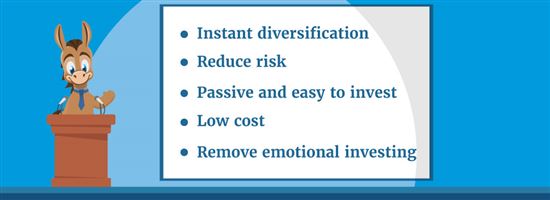How to Invest in Index Funds
Index funds are a low-cost and passive way to invest. If you're afraid of picking the wrong investments, learn how index funds may be a safer option.
 |
Looking for a passive and inexpensive way to invest in the stock market? Consider index funds.
Index funds offer:
- Minimized risk
- Diversification
- Reduced time spent researching, trading, and managing your portfolio
It's a true hands-off method of investing that helps you make the most of your money. Read on to learn if index funds are right for you, and how to start investing.
What Are Index Funds?
Index funds are a collection of investments that track a specific financial market index. For example, an S&P 500 Index fund tracks the 500 largest publicly-traded companies in the U.S., also called the S&P 500 index.
Indexes can be based on:
- Capitalization: These track large-cap, mid-cap, or small-cap companies
- Sector: These funds focus on a specific industry, like technology, financial, health, etc.
- Markets: You can invest in funds that track international or emerging markets
- Assets: There are funds that track stocks, bonds, and commodities
With one investment in an index fund, you're automatically invested in all the stocks it contains. You don't need to pick each asset individually.
You can invest in index funds either through an exchange traded fund (ETF) or mutual fund. We'll go over the difference in a bit.
- Pick an index that interests you, based on capitalization, sector, or markets.
- Choose an ETF or mutual fund for your index (compare expense ratios, performance, and minimum investment).
- Open an investing account if you don't already have one.
- Fund your investing account (consider a regular contribution schedule to continually invest)
- Purchase the index fund shares, and understand what your long-term strategy is.
Are Index Funds a Good Investment?
Any investment carries risk, but index funds minimize it. With lower fees and less work involved, you may see larger capital gains by selecting an index fund vs. investing in a handful of assets individually.
However, despite a historical stock market average annual return of around 10%, market volatility affected every investor over the last year.
Index funds are not exempt from market volatility. But they are generally a good investment if you're in it for the long run. The stock market typically turns itself around, though you must be able to withstand the ups and downs.
Investing in index funds increases the likelihood of "staying put" versus emotionally investing and dumping a stock the minute it takes a turn for the worse. If you have patience, index funds can be a good investment.
Benefits of Index Funds
 |
Here are some good reasons to invest in index funds:
- Instant diversification:
You're automatically invested in hundreds of companies without the research, time, and work involved in buying separate securities. - Reduce risk:
There are hundreds of assets within one fund, so your risk is also diversified. If certain companies that aren't doing well, there are others to balance it out. - Passive and easy to invest:
You don't need to do much research into individual companies. You can "set it and forget it" and just regularly contribute to your fund. This is great for beginners or any investors who wish to be hands-off.For beginners with smaller budgets, you can also invest in stocks. Our guide on how to invest in stocks with little money can help you get started. - Low cost:
Because index funds merely track indexes, they're passively managed. This means they have lower fees than actively managed funds, so you can keep more profits. We'll get more into fees later. - Remove emotional investing:
If you pick individual stocks, it's easy to make rash decisions. You may sell if something's not doing well, or buy when prices are high. With an index fund, you just let it do its thing.
Downsides of Index Funds
It's also important to consider these disadvantages:
- Won't beat the market:
Index funds don't beat the market - they merely mimic or match it. Some poor-performing stocks in the fund will drag down returns. On the other hand, if you made a few really good stock picks, you can experience high returns (though the opposite is also true). - Follows the market:
Index funds ride the waves of the market, both good and bad. In a downturn market, they'll also follow the downward trend. Whereas a human manager could take actions to hedge against the decline. - Less flexibility:
You don't get a say in what you're invested in. You're forced to invest in all stocks within the fund, even if you don't believe in all of the stocks/companies included.
Index Funds Costs
Index funds have a fee called the expense ratio. This pays for the operational costs of the fund, including fund management, admin, and marketing. This fee is taken out of your investment, so it eats into your profits.
But since index funds are passively managed, they have much lower expense ratios than actively managed funds.
Active funds can have expense ratios between 0.5% - 2% (or higher). But index funds usually have lower fees between 0.015% - 0.2%. Some even have no expense ratio at all.
How to Start Investing in Index Funds
Now that you understand the basics of an index fund, let's go over the step-by-step guide of how to invest.
1. Pick Your Index
The most common index is the S&P 500, but there are hundreds of others. Choose the index that most interests you. You can pick indexes based on capitalization, sector, or markets.
Some popular indexes include:
- S&P 500 - Tracks 500 largest US companies
- S&P 400 - Tracks 400 mid-cap companies
- Nasdaq Composite - Tracks technology stocks traded on the Nasdaq exchange
- Dow Jones Industrial Average - Tracks the 30 largest US companies
- Wilshire 5000 - Total stock market index
- Russell 2000 - Tracks small-cap companies
- Bloomberg Barclays U.S. Aggregate Bond Index - Tracks top US traded bonds and some foreign bonds
Most investors only need to pick one index for good diversification. If you want to diversify further, check out the three fund portfolio strategy. This includes investing in 3 index funds of US stocks, US bonds, and international stocks.
2. Decide ETF or Mutual Fund
You can invest in index funds through either exchange traded funds (ETFs) or mutual funds. They work a little differently. Here's a quick explanation.
- ETFs are purchased in shares and traded throughout the day on the stock market. They're usually available on most investment apps, making them more accessible.
A lot of brokerages now even support fractional shares, so you can invest in index ETFs with just a few bucks. This makes it ideal for beginners without a lot of money to start.
- Mutual funds are usually purchased in dollar amounts and trade just once a day at closing. You can purchase them directly through the mutual fund company or through a brokerage, though not all offer mutual funds.
A lot of mutual funds have a $1,000 - $3,000 minimum investment. Though there are a number of $0-minimum mutual funds now.
3. Choose the Index Fund
After choosing the index, you still have a lot of choices for the specific fund. No two funds are equal, so compare by looking at these factors:
- Costs. As mentioned before, it's important to pay attention to the expense ratio. This fee comes right out of your investment proceeds, so it affects your bottom line.
- Performance. Look at the historical performance of the index fund you're considering and see how closely it mimics the index. No index will be "perfect," but the closer you get, the better.
- Minimum investment. This only applies to mutual funds. It may have a minimum dollar amount required. If you don't want to worry about that, then choose an ETF instead.
We give some examples of index funds in this section to help you get started.
4. Open an Investing Account
If you already have an investing account, then see if the funds you want are available there. If you don't have an account yet, it's time to open one.
If you want to invest in index ETFs, they're easily available on just about all investment platforms. Check out some of our favorites apps to trade ETFs for free.
If you want to invest in mutual funds, you can buy directly from the fund company, such as Vanguard or Fidelity. Or you can open a brokerage account that supports mutual funds.
To keep more options open, brokers like E*Trade or TD Ameritrade offers both ETFs and mutual funds. You have more choices and can keep all assets in one place.
5. Buy the Index Funds
After choosing the fund and where to buy it, you'll fund the account and make your purchase. Here are some helpful tips for a successful investing journey.
Create an Investment Plan
It's best if you set up a regular contribution schedule to invest in the fund continually. You can set up automatic transfers on specific dates, so you increase your investment.
The advantage of regular investments is you can use dollar-cost averaging. Rather than chasing the best time to buy, you regularly invest no matter what the price is. Sometimes you may invest when prices are high and sometimes when they're low. This spreads out risk and gives you a decent average over the long run.
Know When You'll Exit
Create an exit strategy before you invest so you don't catch yourself emotionally investing. Have a long-term plan, but leave some leeway should things change. In general, though, index funds are better for long-term investing.
How Much Can You Make Investing in Index Funds?
As with any investment, there's no guarantee of how much money you'll make on the index fund. Historically, the S&P 500 has average 10-year returns of 9.2%. But every fund has different returns and reacts to market changes differently.
While the market can go up and down on any given day, riding out the storm and sticking with your index fund for 5 - 10 years should provide you with decent returns.
You also have the option to reinvest any dividends the fund pays, increasing your investment and returns even further.
Where Can You Invest in Index Funds?
Here are some of the top recommended brokerages to invest in index funds.
Investment apps for ETFs:
- Robinhood: Robinhood offers stock and ETFs with no trading fees. You can buy a fractional share starting with just $1. The app is very beginner friendly.
- M1 Finance: M1 Finance lets you create your custom portfolio, and then it automates your investing plans. It's perfect for those who really wants to be hands-off.
- Webull: Webull may be better suited for more experienced traders. It has advanced research tools and supports fractional shares for as little as $5.
Comprehensive trading platforms:
- E*Trade: E*Trade offers a nice selection of index funds, including those from Fidelity and Vanguard. While Etrade offers no-commission ETFs, there are commissions on some index funds.
- TD Ameritrade: TD Ameritrade also has a nice selection of Fidelity and Vanguard funds. Many Vanguard funds on Ameritrade trade free, but Fidelity funds have a cost (although it's typically lower than other funds and brokers charge).
Mutual Fund Companies:
- Vanguard: Vanguard is perhaps the most well known mutual fund company. It offers around 65 different index funds, including by sector, company size, and geographical market. But note that lots of Vanguard funds require $3,000 minimum.
- Fidelity: Fidelity index funds have some of the lowest rates in the industry. A lot of their funds have $0 minimum investment. They also offer sustainable index funds for socially responsible investors.
- Charles Schwab: Charles Schwab is the third-largest index fund provider. Schwab claims to have the lowest expense ratios on its index funds, and they don't require a minimum investment.
How Can Beginners Invest in Index Funds?
Before you invest in an index fund, there are some things to consider first. Here's how beginners can successfully invest in an index fund:
First, consider your goals and risk tolerance. Ask yourself what you are trying to achieve.
This will help you determine your timeline and how much risk you can take. The further along your goals' end dates are, the more risk you can take, and vice versa.
Then, start narrowing down your options. Do you want to completely diversify and mimic a broad market, like the S&P 500, or do you want to focus on a smaller niche, such as small-cap companies or a geographic area?
Finally, choose your broker or fund manager and invest. Make sure you create an investment strategy, so you continually reinvest in the fund, bringing you closer to your goal.
What Index Funds Should You Invest In?
Everyone has different investing goals, risk tolerance, and financial abilities, but here are four index funds to get you started.
Index ETFs:
- Vanguard S&P 500 ETF (VOO): Invests in all 500 of the largest US companies and has a low expense ratio of just 0.03%.
- Vanguard Value ETF (VTV): Invests in over 300 large- and mid-cap companies. Has a high dividend yield and low expense ratio of 0.04%.
- Schwab US Small-Cap ETF (SCHA): Invests in small-cap companies with the Russell 2000 as the benchmark. The expense ratio is just 0.04%.
- Invesco QQQ (QQQ): Invests in the largest tech companies on the Nasdaq exchange. But note that because it's focused on a specific sector, the risk is not diversified.
- Vanguard Total International Stock ETF (VXUS): Gives you exposure across developed and emerging non-U.S. equity markets.
Index Mutual Funds:
- Vanguard S&P 500 Index Fund (VFIAX): Has been around for over 45 years and is the "epitome" of all index funds. It invests in all 500 companies on the S&P 500.
- Fidelity 500 Index Fund (FXAIX): Covers almost 80% of the market capitalization and is often a solid investment for a retirement portfolio because of its diversification.
- Fidelity Zero Large Cap Index (FNILX): Follows large-cap companies, which most closely mirror the S&P 500. It's offered at zero expense ratio.
- Schwab Total Stock Market Index (SWTSX): Tracks the U.S. stock market. It has a low expense ratio and no minimum investment requirement.
We provide these as examples only. Please do your own diligence and research to make sure it's the right investment for you.
The Bottom Line
Index funds can be a safe and less expensive way to diversify your investments. If you're investing for the long term, it can be a great way to set it and forget it. Investing is a long-term endeavor that can cost you too much money and even end up in serious losses if you try to micromanage.
Finding the right index fund and choosing the right place to buy it is important. Think about your long-term strategy and what other investments you'll hold so you know which options will best suit your portfolio.
Write to Sam Hawrylack at feedback@creditdonkey.com. Follow us on Twitter and Facebook for our latest posts.
Note: This website is made possible through financial relationships with some of the products and services mentioned on this site. We may receive compensation if you shop through links in our content. You do not have to use our links, but you help support CreditDonkey if you do.
|
|
|










